back to
1893 Columbian Exposition Stamps
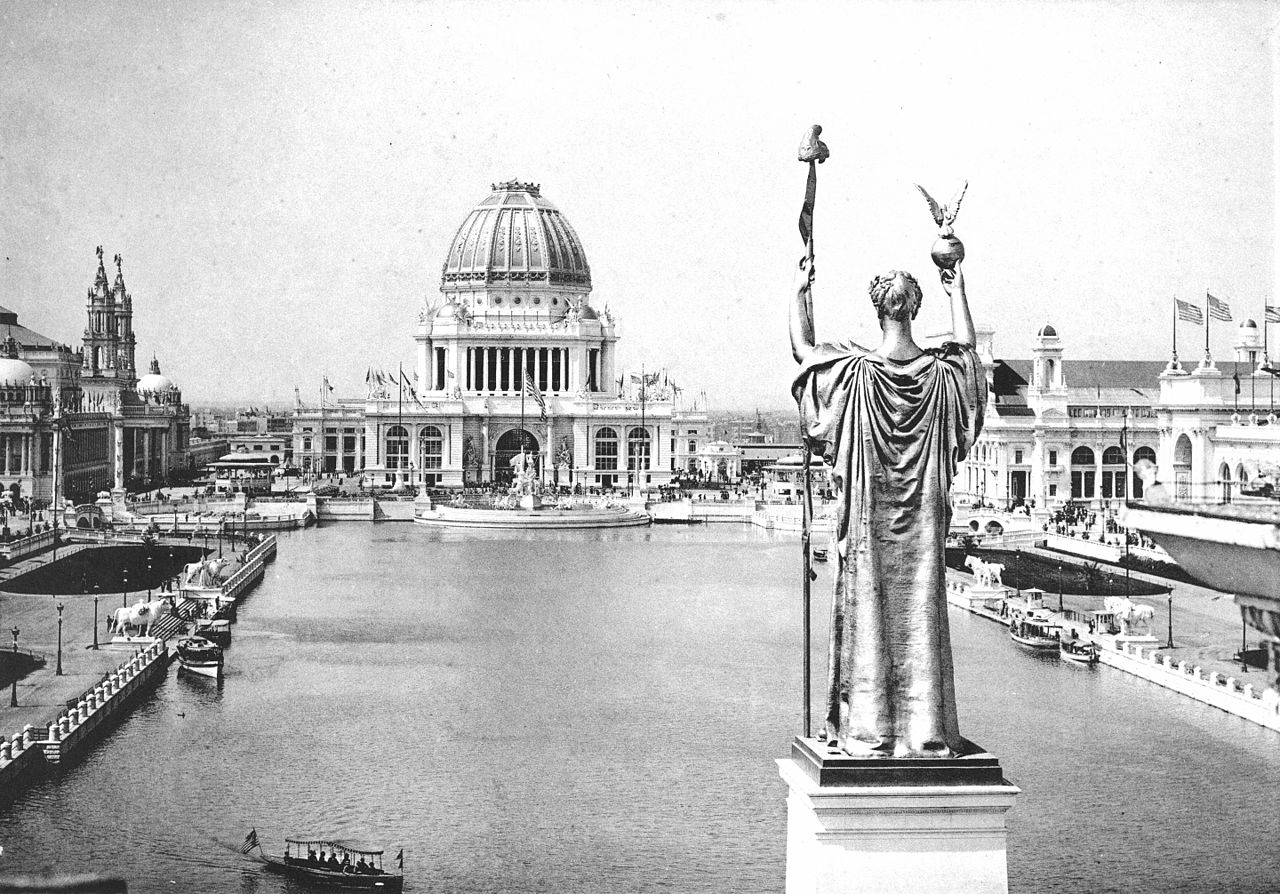
The World Columbian Exposition was held in Chicago from May 1 to October 30, 1893 to celebrate the 400th anniversary of the arrival of Christopher Columbus in the New World, and to promote advances in technology, industry, commerce, arts and social causes. Over the course of 6 months, nearly 27 million came to the specially constructed "White City" to see an incredible array of exhibits, amusements and demonstrations.
The U.S. Post Office used the Exposition as an opportunity to capitalize on the increasingly popular hobby of stamp collecting by issuing a series of pictorial stamps commemorating the voyages of Columbus. The sixteen Columbian Exposition stamps, known to collectors as the "Columbians", were the first commemorative stamps issued by the United States and the first U.S. stamps issued in the larger format that has been used for most commemoratives issued since.
Although the American Bank Note Company held an exclusive contract for printing U.S. postage stamps, Postmaster John Wanamaker negotiated a new contract with the firm specifically for the Columbian stamps, since the previous contract specified only smaller size stamps. The stamps, originally specified as fifteen values ranging from 1 cent to $5, were to be sold at all post offices across the nation. The first 15 stamps went on sale nationwide on January 1 (or January 2 since most post offices were closed on the first), and an additional 8 cent stamp was issued in March to pay the new registration fee. The total face value of the set was $16.34, a substantial sum in 1893 dollars and equivalent to nearly $500 in today's dollars. As a result, few were able to afford the highest values especially since an economic depression in 1893 tightened the budgets of many collectors. The Columbians would remain on sale for one year, and some post offices were instructed to not sell the smaller definitive stamps then in use until their supply of Columbians had been sold.
The designs of the stamps are miniature works of art, based on paintings, drawings and sculpture depicting various episodes from the life of Columbus, and were chosen by Postmaster General Wanamaker and James MacDonough, head of the American Bank Note Company. They are beautiful examples of the engraver's art and are among the most prized of all United States stamps. They would be the final U.S. stamps printed by a private firm for 50 years, when the American Bank Note Company was again employed to print the "Overrun Nations" stamps in 1943. In 1894 the American Bank Note Company failed to win a renewal of its contract because the Bureau of Engraving and Printing submitted a lower bid, and the BEP would print a majority of the nation's postage stamps for the next century.
Some experts believe the BEP may have provided the finishing work on the final print run of the Columbians. The earliest printings exhibit the clean-cut perforations typical of the stamps of the American Bank Note Company, while the later printings show the rougher and occasionally unpunched perforations consistent with the earliest stamps printed by the BEP. These experts believe that when the contract with the American Bank Note Company expired, unfinished sheets were shipped to the BEP where they were perforated as their first project under the new contract and sent to post offices.
Design Sources for the Columbians
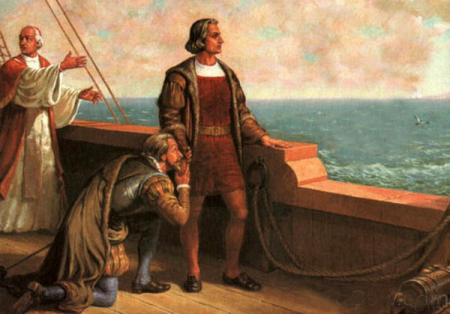 |
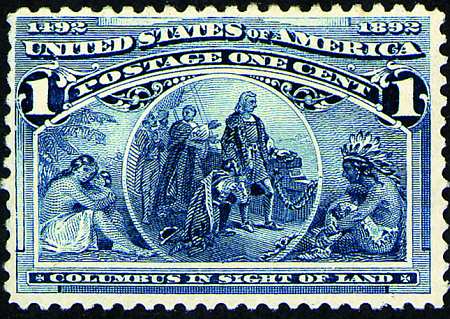 |
|
1¢ Columbus in Sight of Land (Scott #230) "Columbus in Sight of Land" is based on a painting by William Henry Powell, flanked by a Native American woman and child on the left and a chief on the right. The original painting, once believed to be lost, resides in a private collection in New York City. |
|
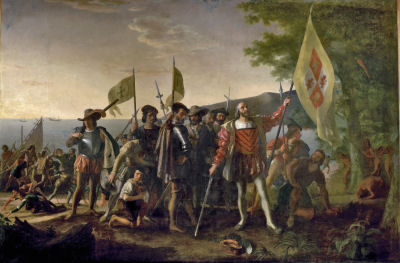 |
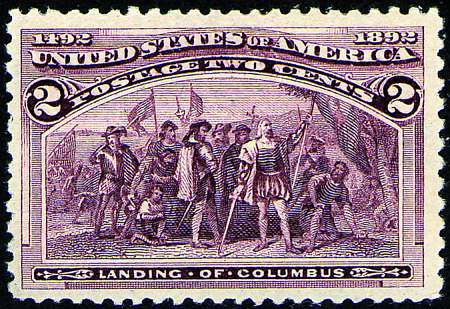 |
|
2¢ Landing of Columbus (Scott #231) The "Landing of Columbus", painted by John Vanderlyn in 1837, hangs in the Rotunda of the U.S. Capitol. It shows Columbus coming ashore on the island of San Salvador in the West Indies, with natives and sailors kneeling at the sight of Columbus. Notice this stamp shows a bearded Columbus while he is clean shaven on the 1 cent stamp. |
|
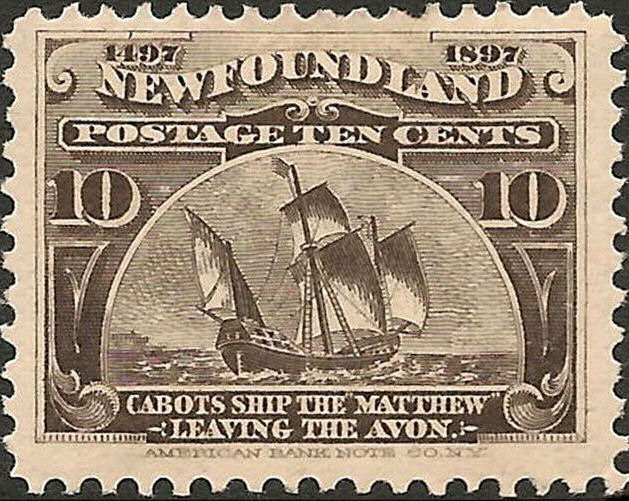 |
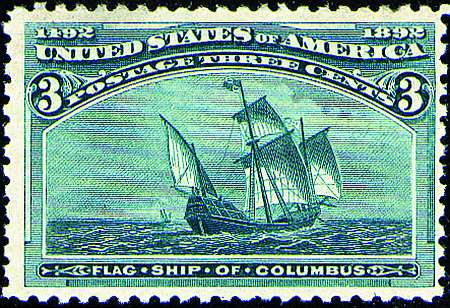 |
|
3¢ Flag Ship of Columbus (Scott #232) The source of the "Flag Ship of Columbus", the Santa Maria, has been lost to time but is said to be from a Spanish engraving. However, the identical picture was used for an 1898 stamp from Newfoundland, as Cabot's ship "Matthew"! It is typical of the sailing ships from the time of Columbus. The last known copy of the original Spanish engraving is believed to have been lost during the Spanish Civil War. There is some controversy surrounding the source of this design. Another belief is that it comes from a drawing published in L'Amerique Francaise magazine, and the Smithsonian National Postal Museum suggests it is based on a model of a 15th century ship in the Smithsonian's collection. |
|
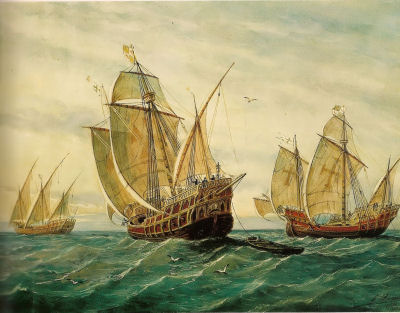 |
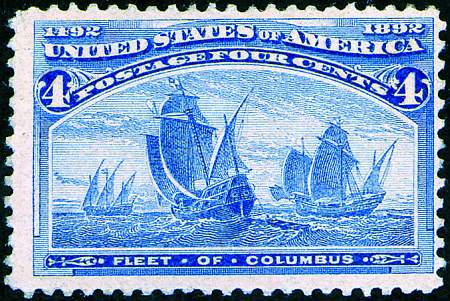 |
|
4¢ Fleet of Columbus (Scott #233) The "Fleet of Columbus" shows the Nina, Pinta and Santa Maria. The Santa Maria was the largest ship in the fleet. It is based on the 1885 painting "La Armada de la Indies" by Rafael Monleon y Torres which hangs at the Spanish Naval Museum in Madrid. It was used as the basis of the engraving "The Ships of Columbus" by Gustav Adolf Closs is 1892. On Christmas Day, 1492, the Santa Maria ran aground while en route to Cuba and was abandoned. |
|
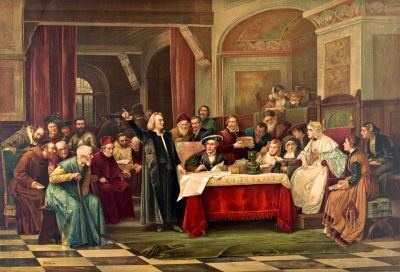 |
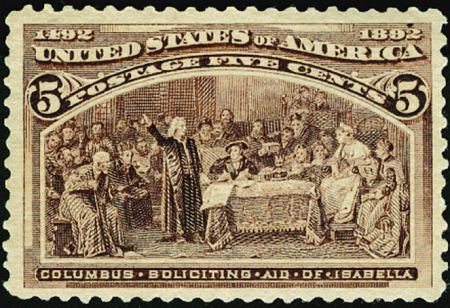 |
|
5¢ Columbus Soliciting Aid of Isabella (Scott #234) "Columbus Soliciting Aid of Isabella" is from an 1884 painting "Columbus at the Court of Ferdinand and Isabella" by Bohemian artist Vaclav Brozik, and shows Columbus seeking support from the King and Queen of Spain. The painting was originally owned by the Metropolitan Museum and now hangs in the dining room of the Hotel Manoir Richelieu in Quebec. |
|
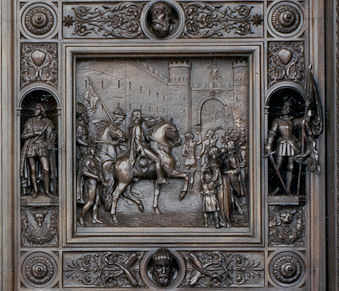 |
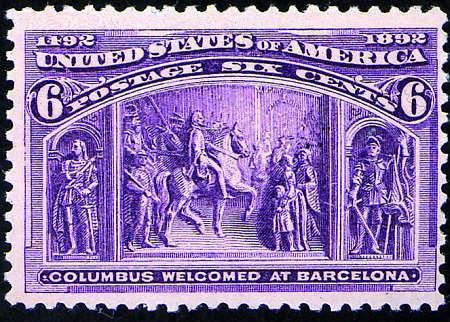 |
|
6¢ Columbus Welcomed at Barcelona (Scott #235) "Columbus Welcomed at Barcelona" is taken from a bas-relief bronze door panel installed in Rotunda of the U.S. Capitol in 1864 by sculptor Randolph Rogers. Rogers designed 9 panels on these doors, which are 17 feet high and weigh 20,000 pounds. Columbus was given a hero's welcome upon his return to Barcelona in 1493. Flanking the panel are statues of King Ferdinand and explorer Vasco Nunez de Balboa. |
|
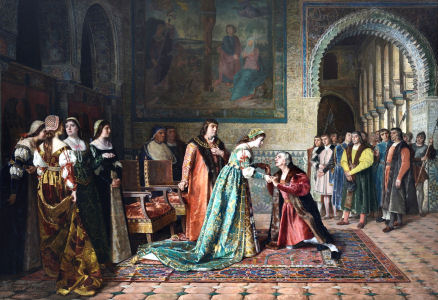 |
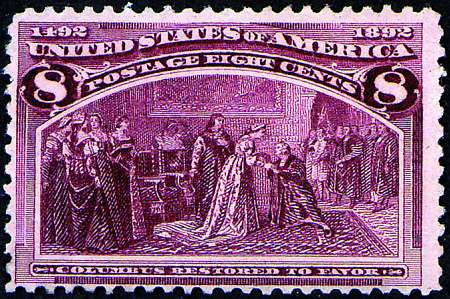 |
|
8¢ Columbus Restored to Favor (Scott #236) "Columbus Restored to Favor" reproduces a painting by Francisco Jover y Casanova called "The Affectionate Reception of Columbus by Ferdinand and Isabella" which is on display at the Valladolid University in Spain, showing Columbus in the court of the King and Queen of Spain after his second voyage to the New World. It was the first U.S. 8-cent stamp, issued 2 months after the other stamps in this series, and paid the new reduced registry rate. |
|
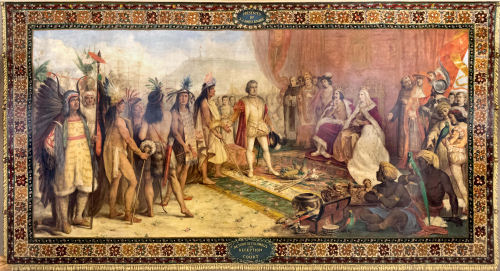 |
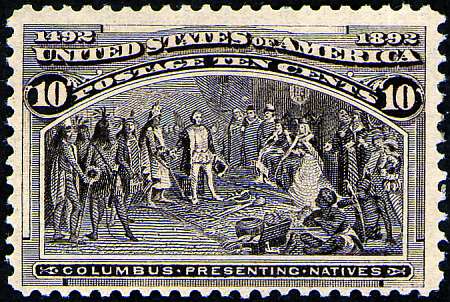 |
|
10¢ Columbus Presenting Natives (Scott #237) "Columbus Presenting Natives" is from an 1880s mural on plaster by Luigi Gregori called "Return of Columbus and Reception at Court", at the Main Building of the University of Notre Dame in Indiana. In 2019 the series of 12 murals was deemed controversial and covered from view. In order to prove he reached the New World, Columbus forcibly captured natives from the Bahamas and took them back to Spain. The court must have been held outdoors under a canopy since the masts of ships can be seen in the background. |
|
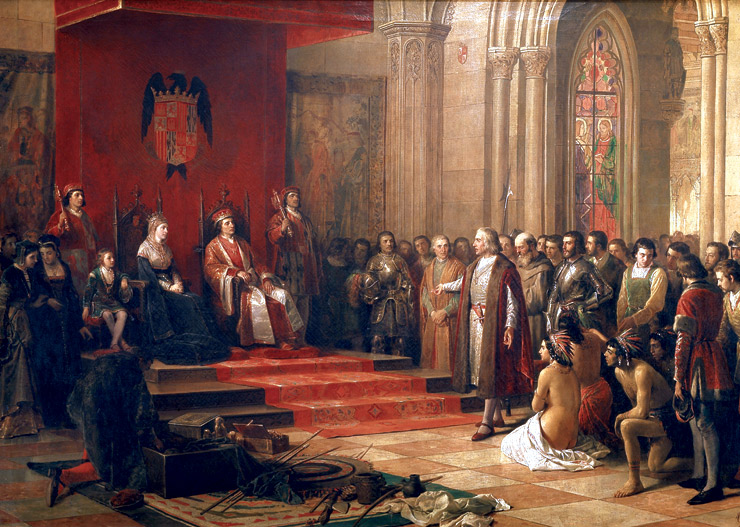 |
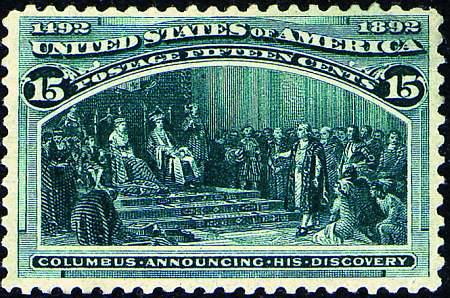 |
|
15¢ Columbus Announcing His Discovery (Scott #238) "Columbus Announcing His Discovery" is from a painting titled "Columbus Received by the Catholic Kings After His First Travel" by Spanish artist Ricardo Balaca y Cancico and shows the triumphant Columbus reporting the news of his discovery to his benefactors, the King and Queen of Spain in 1493. The painting is lost and may have been destroyed during the Spanish Civil War. |
|
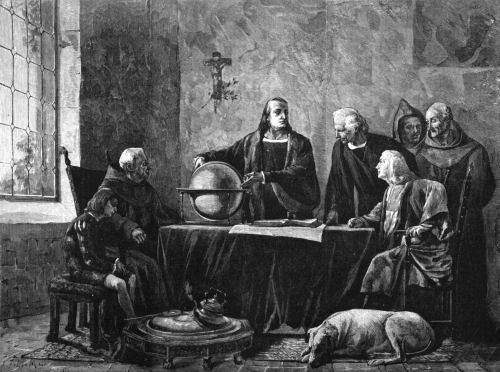 |
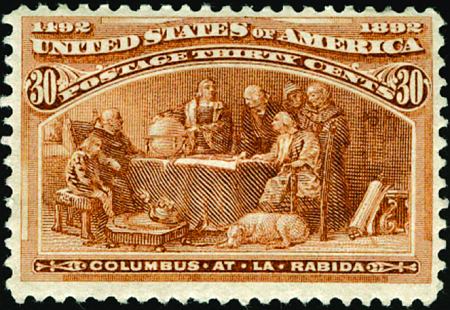 |
|
30¢ Columbus at La Rabida (Scott #239) "Columbus at La Rabida" is from an 1876 painting by Felipe Maso de Falp called "Columbus Before the Franciscans at La Rabida". The painting is believed to be lost. In 1490, after the Spanish refused his pleas for support, Columbus shifted his focus to the French Court, and his travels took him through La Rabida, where he accepted the hospitality of the local monastery. It was here he met Martin Alonso Pinson, who later became commander of the Pinta. |
|
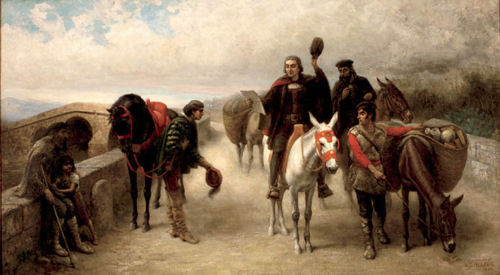 |
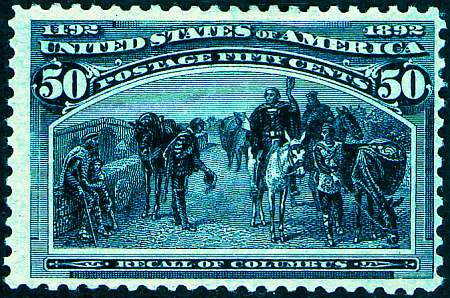 |
|
50¢ Recall of Columbus (Scott #240) "Recall of Columbus" is from an 1882 painting by Augustus Goodyear Heaton that hangs in the Senate Wing of the U.S. Capitol. Refused for Spanish support for a second time in 1492, this shows Columbus astride a mule on the road to France, when a messenger approached and announced that the King and Queen of Spain had agreed to support his voyage. |
|
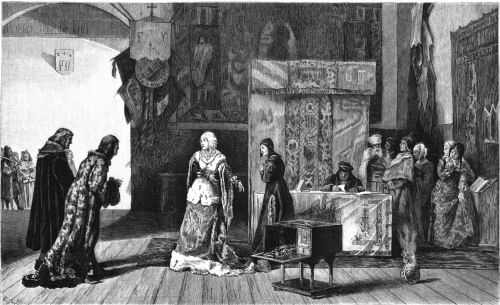 |
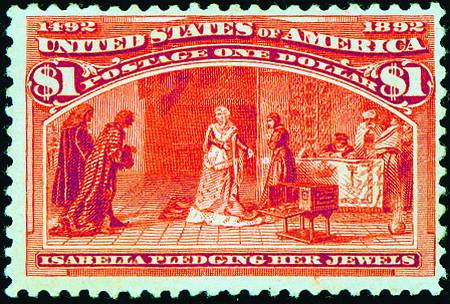 |
|
$1 Isabella Pledging Her Jewels (Scott #241) "Isabella Pledging Her Jewels" is taken from an 1878 painting by Antonio Munoz Degrain, which is believed to be lost. The conquest of the Moors in 1492 had depleted the Spanish treasury, and while it is believed Isabella did offer her jewels to finance the voyage, it was never done as money was pledged from other sources. |
|
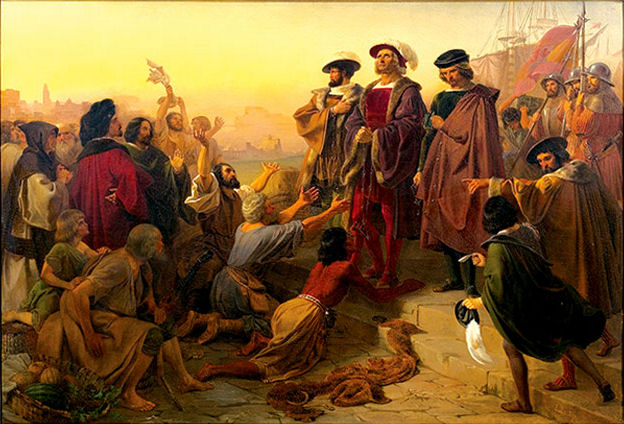 |
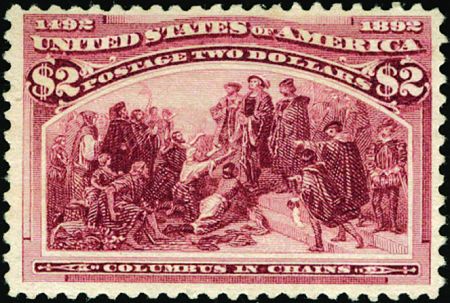 |
|
$2 Columbus in Chains (Scott #242) "Columbus in Chains" is based on an 1841 painting by Emanuel Gottlieb Leutze called "Return of Columbus in Chains to Cadiz", which is on display at the State Department in Washington DC. Accused of administrative misconduct while governor of Spain's New World colonies, Columbus was arrested, shackled and returned to Spain, where he was eventually acquitted. |
|
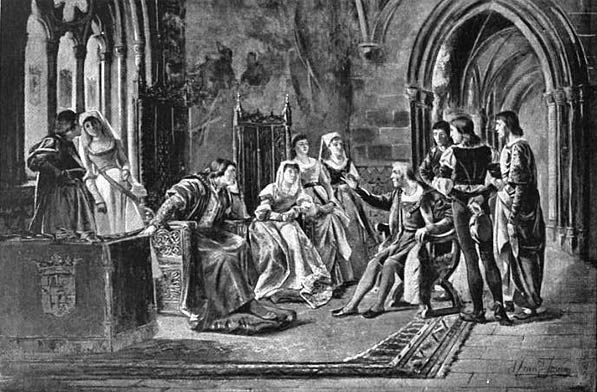 |
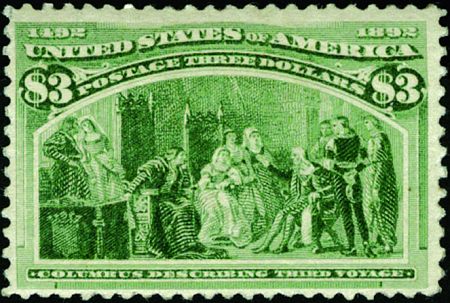 |
|
$3 Columbus Describing Third Voyage (Scott #243) "Columbus Describing Third Voyage" is from the painting "Columbus Before the Catholic Kings" by Francisco Jover y Casanova made around 1881 and now believed to be lost. On the third of his four voyages, Columbus led a fleet of 17 ships and 1200 men, and returned to Spain in 1500 where he told of his discoveries including the exploration of Puerto Rico. |
|
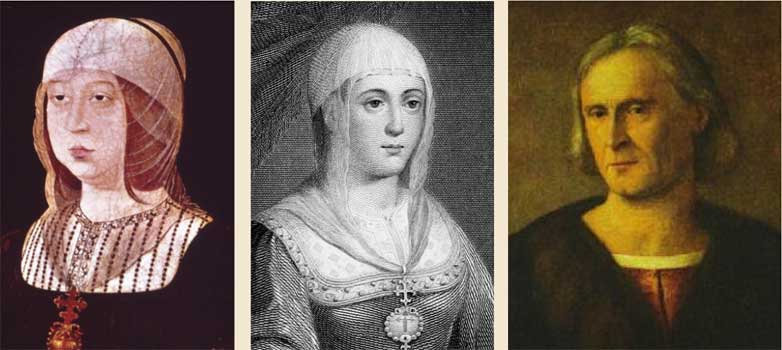 |
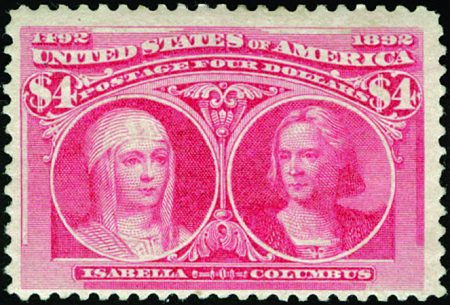 |
|
$4 Isabella and Columbus (Scott #244) "Isabella and Columbus" was the first U.S. stamp to depict the portrait of a woman. The portrait of Isabella is from an unknown source, possibly Bartolome Bermejo, which has inspired numerous portraits over the years including this engraving from 1839 which closely resembles that used on the stamp. The portrait of Columbus is by Lorenzo Lotto completed in 1512, believed to be the most accurate portrait of Columbus. With less than 27,000 printed, it had the smallest printing of any stamp in the series. |
|
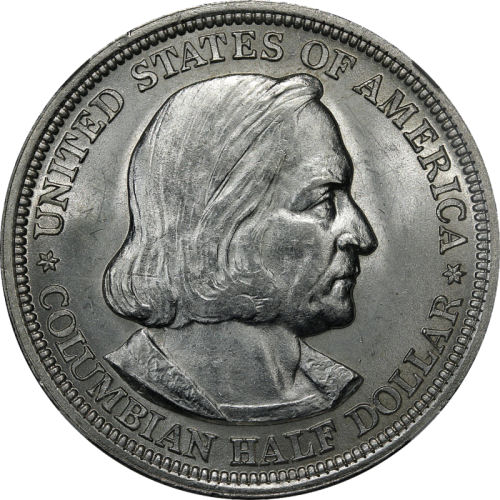 |
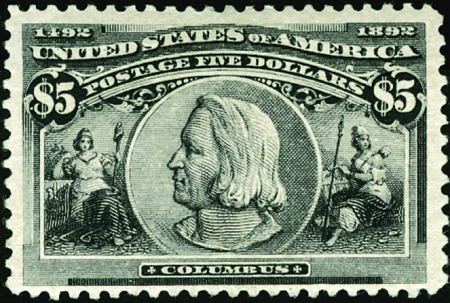 |
|
$5 Columbus (Scott #245) The $5 value, the highest face value U.S. stamp at the time, shows a portrait of Columbus taken from a plaster cast made by the Treasury Department based on a medal struck in Madrid. Commemorative half dollars were issued at the same time using the same portrait. The figures in the side panels are "America" and "Liberty". Today this stamp occupies an almost mythical position among collectors for its rarity and simple beauty. |
|

